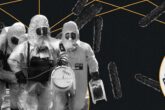March 23, 2021
Steering in the Right Direction in the Military-Technical Revolution
A couple of years ago at the Beijing Xiangshan Forum, a senior executive at one of China’s largest defense companies claimed that “mechanized equipment is just like the hand of the human body.” He continued, “In future intelligent wars, AI systems will be just like the brain of the human body.” More recently, the People’s Liberation Army sought broad participation from young technology-savvy inventors in an AI challenge-style competition to develop the best algorithms to direct joint military forces in a realistic fight over a disputed island territory — in other words, Taiwan.
We should not be surprised. China believes that AI-enabled “intelligentized combat operations” will be central to surpassing the United States in the emerging military-technical revolution. It is developing new warfighting concepts to harness big data, swarm intelligence, automated decision-making, and autonomous unmanned systems and robotics in ways that could give it a decisive military advantage on the battlefield. China is also investing heavily in supporting technologies like quantum computing and 5G, and is leveraging its approach to military-civil fusion to focus its brainpower and resources on bringing these concepts to life. We assess that, in the big picture, the military-civilian fusion is generally working for China as a successful stratagem.
The United States requires a similar whole-of-nation effort that coordinates the entire U.S. national security enterprise with heavy involvement and attention from leaders at the highest level.
The United States requires a similar whole-of-nation effort that coordinates the entire U.S. national security enterprise with heavy involvement and attention from leaders at the highest level. For their part, the Department of Defense and the intelligence community ought to be focused on developing new strategic concepts that rely less on unquestioned military overmatch, in the traditional sense, and more on the rapid adoption of emerging technologies. In order to realize this vision, they should take the unsexy but important first step of creating a Steering Committee on Emerging Technology. This body, which represents a key recommendation of the National Security Commission on Artificial Intelligence, would oversee technological strategies and adoption across the national security enterprise, providing a level of coordination and planning that is absent today. And if it remains absent, it could cost the United States and its allies dearly.
Read the full article from War on the Rocks.
More from CNAS
-
Make America the Biopower
No country has a better biotechnology hand than America. The administration has a historic opportunity to play it wisely and secure the United States’ position as the 21st cen...
By Vivek Chilukuri
-
Sharper: Drones on the Battlefield
From the battlefields of Libya to Nagorno-Karabakh to Ukraine, the deployment of drones has become a critical element of modern warfare. Will the explosion of unmanned aerial ...
By Anna Pederson & Molly Campbell
-
AI and the Evolution of Biological National Security Risks
New AI capabilities may reshape the risk landscape for biothreats in several ways. AI is enabling new capabilities that might, in theory, allow advanced actors to optimize bio...
By Bill Drexel & Caleb Withers
-
Biotech Matters: Problems with Life Science Databases in the United States
While humans will retain their ultimate mysteries, many aspects of their traits, diseases, and environment are becoming increasingly tractable. Much of this advance has come f...
By Carol Kuntz




